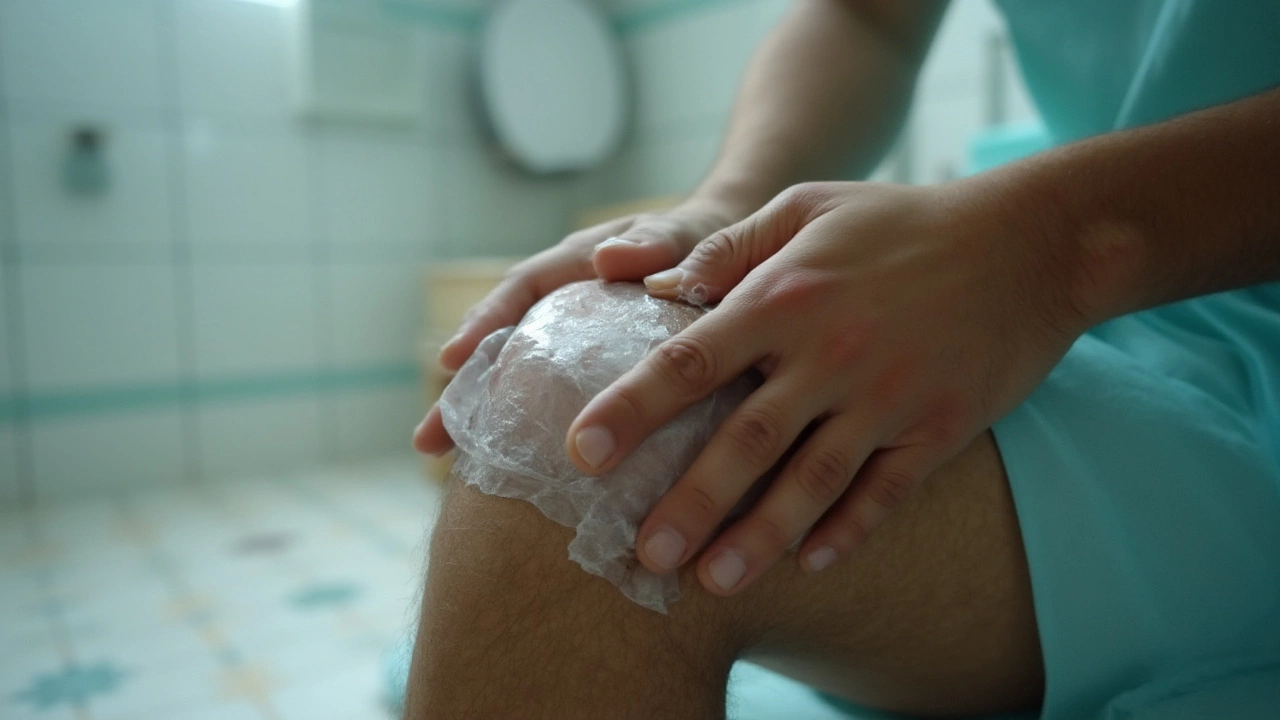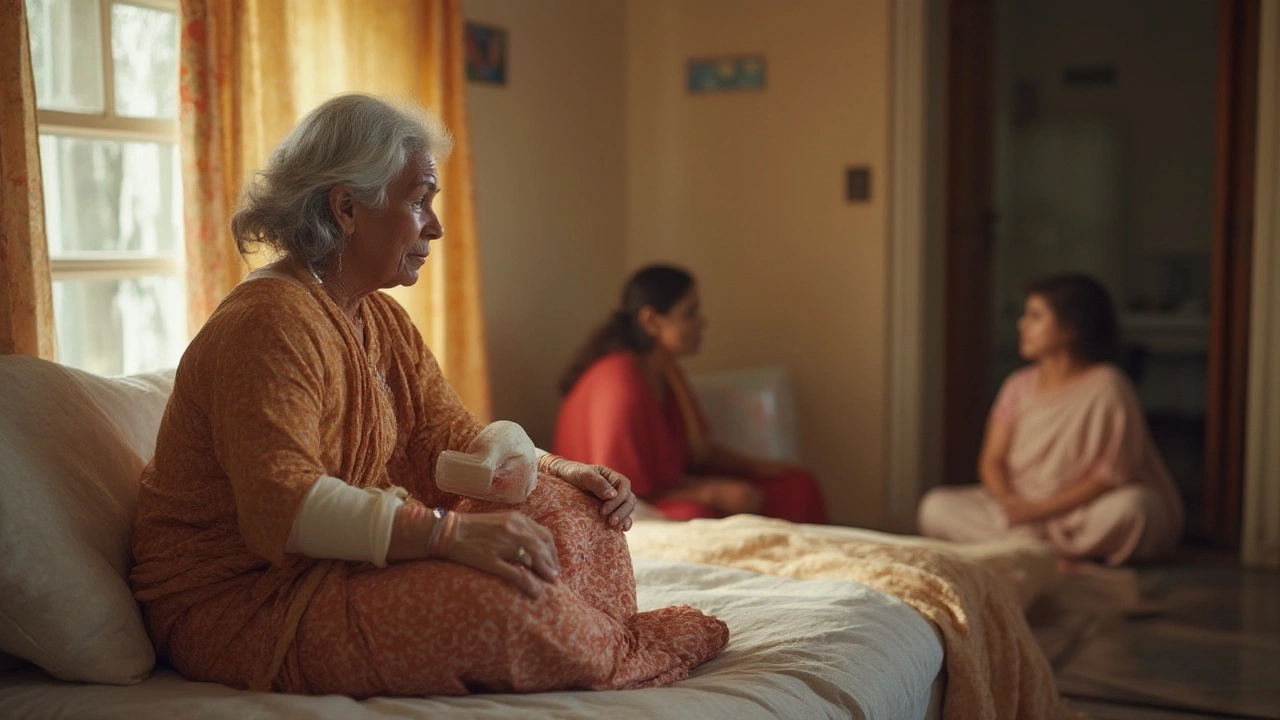Getting knee surgery kind of hijacks your daily routine in ways you don’t expect. You're suddenly looking at body wipes and awkward sponge baths because your surgeon just told you, “Hold off on showering.” Wait, really? After slicing and fixing your knee, you just want to feel clean. But there’s a medical method behind the madness, and it all comes down to wound healing and protecting that fresh surgical site from trouble.
What Happens During Knee Surgery?
Knee surgery isn’t just one thing; there’s a long menu—arthroscopy for torn meniscus, total knee replacements, ligament repairs. Let’s keep it real: the one thing all these procedures have in common is a new incision, sometimes a couple, and a healing pathway for your body. No matter if it’s a two-inch cut or a cross-shaped zipper running over your kneecap, your body has to close it up, stitch by stitch, cell by cell.
But while you’re chilling on the couch catching up on old sitcoms, every shower could upset this delicate healing work. The incision, covered in its sterile dressing, isn’t waterproof until you get an all-clear from your surgical team. Water isn’t just water. Showers send a rush of soap, microbes, and chemical-laden tap water right onto your skin. Even quick sprinkles can loosen tape or dissolve glue, sometimes working their way into the wound before it’s sealed tight. Data shows that wound infection rates range dramatically between 1-5% in clean surgeries, but that risk spikes if wounds are exposed to moisture early, compromising sterility or adhesion of dressings. That’s a huge deal when you consider bacteria like Staph love warm, damp environments—like a knee with fresh stitches hit by non-sterile water.
Your knee after surgery is basically ground zero for healing. The underlying tissues, muscle, ligaments, and skin layers need to knit together. If water gets in, not only can bacteria join the party, but you run the risk of wound breakdown, maceration (soggy skin), and slower tissue repair. It also means glued shut edges could open up, hardware might get exposed, and you might find yourself back at the hospital, risking another operation or more antibiotics. Long story short: there’s a reason your surgical team sounds a little over-cautious here.
There’s also another little-known reason: balance! Standing in a slippery shower too soon means you could easily lose your footing (seriously, post-op knees don’t forgive clumsy moves). So while wound care is crucial, your own safety—keeping your knee and the rest of you out of harm’s way—matters just as much.
Check out this table for common surgeries and their typical no-shower timelines approved by the American Academy of Orthopaedic Surgeons:
| Knee Surgery Type | Typical No-Shower Period | Notes |
|---|---|---|
| Arthroscopic Surgery | 24-72 hours | When bandage removed, as advised by surgeon |
| Partial Knee Replacement | 7-10 days | Until sutures/staples removed or incision dry |
| Total Knee Replacement | 7-14 days | Varies by closure and wound healing |
| Ligament Repair (ACL/MCL) | 5-10 days | Depends on incision and closure technique |
Risks of Early Showering (and How Infections Really Happen)
Ever heard someone insist they started showering just a day after surgery and were totally fine? They got lucky. Early showering leaves the door wide open for germs. The biggest risk is infection. Not just redness or warmth around stitches, but deep infections that settle in hardware (like metal screws or prosthetics). When bacteria find a new place, they're hard to kick out. Surgical site infections (SSIs) happen for around 1% of knee surgeries in top hospitals, but that number jumps if wounds get wet too soon, or if the dressing is disturbed. Trouble is, symptoms don’t always hit straight away. Sometimes it’s 2-3 days after you’ve “cheated” on showering, with swelling, heat, and drainage that wasn’t there the day before.
It’s not just tap water you have to blame. Even clean-looking water can carry bacteria, especially if your home’s plumbing has a sneaky biofilm lurking inside the showerhead. The moment you peel back a dressing too soon or soak a sticky wound in a steamy shower, you could break down that fragile barrier. Once germs gain access, they start reproducing. Some can form biofilms over implants, which makes infection incredibly tricky to treat. Sometimes this means IV antibiotics, wound reopening, and months of added rehab—something I wouldn’t wish on anyone, especially after watching my neighbor go through that three years ago after kneecap surgery.
There’s also the simple problem of water dissolving wound adhesives. Modern stitches and surgical tapes are designed to resist everyday sweat and humidity, not direct water jets. Weak adhesion means your surgical wound is more likely to open up or leak. Plus, with nerves still healing, you might not notice if you push or tug on an area you shouldn’t. Combine that with soapy residue or residue left over from medicated dressings and you could see contact dermatitis or delayed healing.
Surgical guidelines often say that most waterproof dressings can’t be trusted after a certain point—after about 3 days, their reliability drops because skin oils and friction cause seal breakdown. So if you’re thinking of just wrapping your knee in a plastic grocery bag, be warned: water finds a way! Real waterproof wound covers are different—they use medical-grade adhesive, but even these need surgeon approval before you get trigger-happy with the shower knob.
Here's something else: a recent review in the Journal of Wound Care (2022) found infection rates for exposed wounds doubled, and wet wound dressings delayed closure by 2-3 days. Speed matters when you’re trying to get back on your feet, so sticking to the post-op rules buys you real recovery time. Plus, nobody wants that itchiness, stickiness, and anxious peeking under the bandage every morning just to see “if it’s OK yet.”

The Best Ways to Stay Clean Until You Can Shower
So what’s left if the shower is temporarily banned? Here’s where my own experience (and anyone else watching their post-op reflection wondering, “How am I going to smell decent for a week?”) really kicks in. The answer: get creative, and think like a nurse on a long shift.
First, grab some high-quality body wipes meant for bed-bound people. The bigger, the better. These wipes won’t just clear off sweat—they include antibacterial properties, and they don’t leave you feeling sticky. No shame in asking a partner or close friend to reach tough spots: Aria had to help me under my leg and behind the knee with a gentle wipe more than once, and it saved my sanity.
Basin or sponge baths are next-level. A plastic wash basin with warm soapy water and a soft cloth works wonders. Stick to gentle, fragrance-free soaps. Always start with your face, then move downward—think hospital protocol. Keep contaminated water far from any surgical incision, and always finish with a clean towel. Avoid rubbing near the wound; instead, gently pat dry.
If your hair's a mess, try a dry shampoo or a no-rinse shampoo cap. They’re not just for people in hospitals—they do a good job hiding the fact that you haven’t been under a showerhead for a week. For arms and other non-operative limbs, you can clean normally, just steer clear of spray or splash onto your knee area.
Deodorant helps, but avoid sprays or sticks around the wound site—use it only where the skin is far from the surgical zone. Wear fresh, loose-fitting clothes each day, and swap out bedding with help if you can; nothing gets stale faster than old bedsheets and pajamas when you’re healing. Lay out your post-op wardrobe in advance so it’s easy to reach and you don’t have to ask for help at every turn.
Keep the post-op area totally dry. Any accidental dribble or splash? Dab, don’t rub, with a clean cloth. If a bandage ever gets saturated, call your surgeon’s office—don’t try to fix it solo. There’s no point gambling a clean bill of health for the sake of feeling extra fresh one day sooner.
- Use hospital-grade wipes for body and groin cleaning
- Have a partner help with hard-to-reach areas
- Try disposable shampoo caps to freshen up hair
- Change clothes and sheets daily to minimize bacteria buildup
- Rinse mouth often (nothing worse than hospital breath!)
- If wound gets wet, immediately pat dry and notify your surgeon’s nurse
When Will You Actually Be Able to Shower? What Doctors Usually Say
Patience really is the unsung hero of knee surgery recovery. The question—when exactly can you shower—doesn’t have a single answer. Surgeons make this call based on how your wound was closed (staples, glue, stitches), the stability of your bandage, and your healing progress. Here’s where direct communication absolutely wins out; don’t guess or follow someone else’s YouTube story.
Most modern arthroscopic incisions, when sealed well with Steri-Strips and medical glue, can see a gentle (not hot or high-pressure) shower in as little as 48 hours, but only after removing the bandage—unless advised otherwise. With joint replacements, open surgeries, or incisions that required internal stitches, you could be waiting up to two weeks. Surgeons want to see no draining, scabbing, or redness before giving the thumbs up. If there’s still any wet drainage, or the wound hasn’t formed a tough scab, that water stays off-limits.
If your doctor okays it, always use a waterproof cover (the kind labeled for surgical wounds). Don’t trust makeshift hacks—medical adhesives are your friend. Keep the shower short. No soaking, no baths, and definitely no hot tubs or pools. Aim the spray away from your surgical site, and never scrub your wound. Afterward, remove the cover carefully, pat the area dry with a clean towel, and check your wound—if anything looks dicey, call the office.
One interesting fact: multiple clinical trials now show that early, controlled showering with waterproof dressings under supervision does not increase infection if done right. A big study published by the British Medical Journal (2021) tracked over 1,000 post-knee surgery patients. Those who waited at least 48 hours and used proper wound protection saw no difference in healing or infections, compared to those who waited a full week. But—and it’s a huge but—everyone in that early shower group got detailed wound protection and nurse instruction first. Their wounds were dry, non-draining, and they didn’t try to shortcut the process.
Got questions about drainage, appearance, or weird sensations? Ask your care team at every follow-up. And absolutely don’t start “testing” the rules with wet towels, tub soaks, or letting the shower run right over your incision before getting the green light. That’s a quick ticket to derailment—and believe me, it’s not worth it for a five-minute shower high.
The big thing to remember? Showers are a small sacrifice for a fully healed knee. Soren, my science-loving kid, summed it up best when I complained about sponge baths: “Would you rather be stinky for a week…or walk pain-free for life?” Kind of puts it all in perspective.
Shower after knee surgery isn’t just a personal comfort thing—it’s a critical step in protecting your new, healing knee. So, if your bathroom feels off-limits, just know that every sponge bath brings you one step closer to fully rejoining daily life, water jets and all.
August 1 2025 0
Write a comment